Bamboo will add a premium look to your aquarium aquascape. But you may want to know what kind of bamboo tree you should put in the aquarium and how it affects your fish. Many aquarium keepers, like the concept of using Lucky Bamboo In Aquarium. But is it suitable for fish and other animals (like srimps)?
Everything you put into the tank must be checked for its safety. Because some plants are poisonous to fish and can degrade water quality. Bamboo plants are considered nonpoisonous plants. But if you use real Bamboo, it can degrade water quality by releasing ammonia (rotting). So the real question is what type of bamboo is safe for your aquarium?
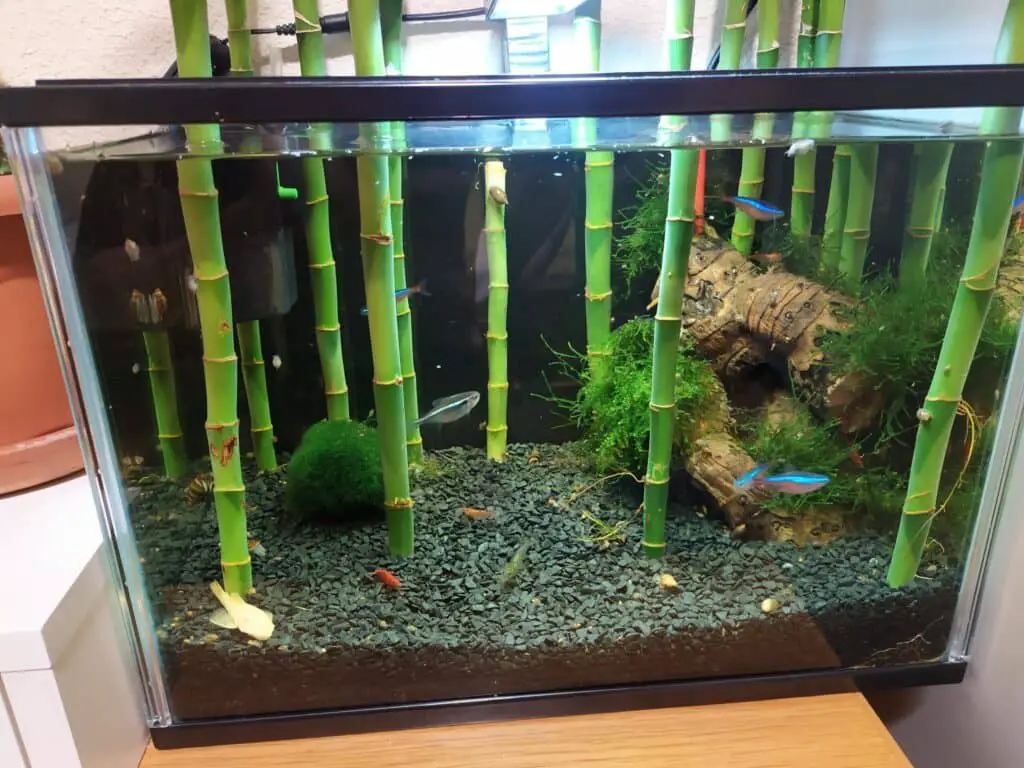

The real bamboo is not the answer; it degrades very easily when submerged in water. It also releases ammonia and other nitrogen compounds that are toxic to fish. But this is a slow process. It will take some time.
However, you can use a Dracaena Sanderiana (lucky bamboo) in the aquarium. It does not rot when submerged and it would be the ideal species of bamboo for your aquarium. But the pro tip is not to fully immerse lucky bamboo in the water. Other than that, you can also use Poaceae sp. ‘Purple Bamboo in your aquarium.
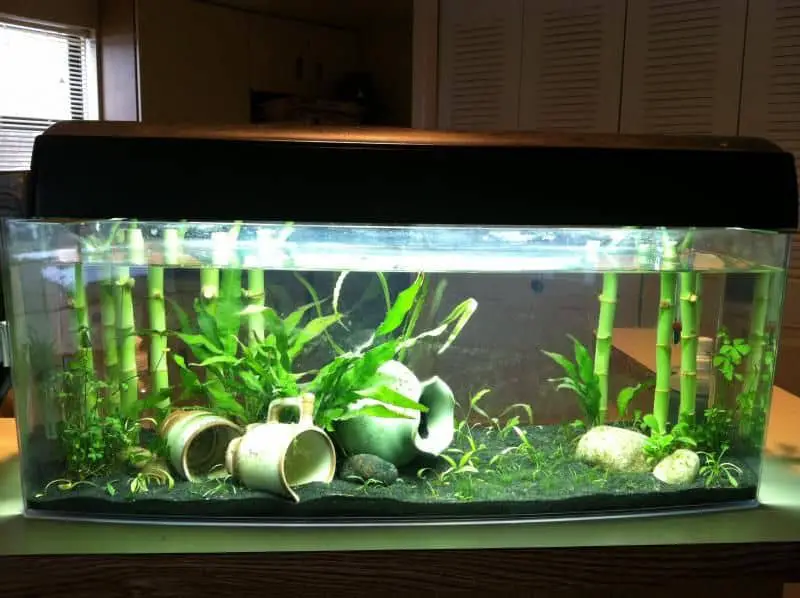
Even though growing Lucky bamboo and Purple Bamboo is not harmful to your fish, you should take necessary precautions before planting them.
As mentioned earlier, these two plants do not rot and release ammonia into the water. But for this, it is essential to plant the lucky bamboo and Purple Bamboo properly. I also gathered some other details about popular and lucky bamboo that could address your curiosity.
Jump To
Real Bamboo vs. Lucky Bamboo vs. Purple Bamboo Bamboo In an Aquarium
True bamboo, lucky bamboo and Purple Bamboo are totally different species, but they are look alike. Therefore, you should be extra safe about what you buy.
When you add true bamboo into your tank water, it will start to rot and decay. It gradually becomes harmful to your fish, as its breakdown down and releases ammonia and other contaminants into your fish tank.
When comparing normal bamboo with lucky bamboo, it looks like they grow and behave within your tank the same way, but it is very different. Lucky bamboo will live in your tank by being completely submerged in water, or partly submerged. The same goes for the Purple Bamboo; it will live in your fish tank fully submerged, partly immersed, or emerged.
You can see many discussions on the best way to add lucky bamboo and Purple Bamboo to your aquarium and whether to fully submerge the plant or leave the plant’s top outside your water level (leaves in the air). It is recommended to keep the top of the plant outside your tank water level.
Under normal conditions being above the water (leaves above water) is recommended for the lucky bamboo, because it will not grow properly when the leaves are submerged. If leaves are submerged leaves will begin to rot. The entire plant will die eventually. The sure sign of decay is yellow color leaves or stems. But even at this stage, the bamboo plant can be revived. if you want to use true bamboo can use resin-treated true bamboo.
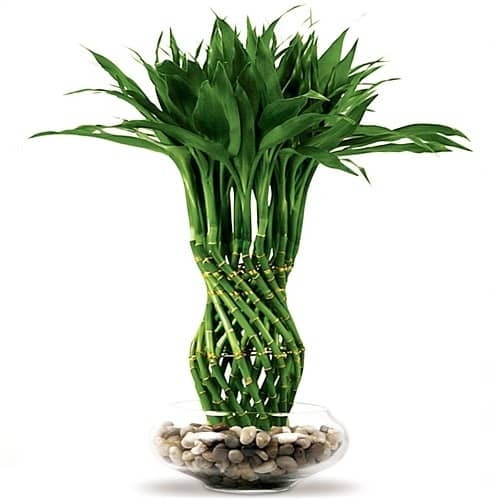

Read More Is It Safe To Put Dried Bamboo In An Aquarium?
Benefits of bamboo in a fish tank
natural water filter
The best way of filtering is natural water filtering provided by the aquatic plant. A good example is a lucky bamboo. It is a great way to filter your aquarium water. The bamboo can collect and feed on fish waste through its roots. It also absorbs nitrogen waste material from fish such as nitrites, and ammonia, and prevents the accumulation of toxins.
Attractive looks
In freshwater aquarium design, adding lucky bamboo is a great way to spice up your fish tank and improve your fish’s health. For your fish, it sure makes the fish tank homier. But the key point is that the aquatic plant should be kept safe or it can affect tank water quality when plants are unhealthy.
Bamboo aquarium set up
How to add
There is some basic stuff, you need to consider when growing bamboo in an aquarium.
Read More : Is Hot Glue Aquarium Safe? 12 Secrets Only A Handful Of People Know
Substrate
There may be just a few inches of substrate in your tank, but if you can increase that depth by around four inches, this will better suit your bamboo plants. That will provide more nutrients for your aquatic plant. Guaranteeing the roots are well under the substrate is one of the first things you need to monitor; also keeping a few pebbles around the roots can stabilize the plant in water. The deeper the roots go, the less likely they can grow above your substratum.
Water quality
The water should be clean and free of toxins such as chlorine. It should be free of any material that can harm life in the tank. This way, the plant will not rot, the leaves will continue to grow, and there will be more healthy overall growth.
Lucky bamboo is a hardy plant and can accommodate a wider range of water parameters. It is so easy to maintain but you should keep track of the water temperature. Lucky bamboo can withstand a wide range of temperatures from 59 to 80 ° F. It is ideal for cold and tropical aquariums.
Eventually, high levels of ammonia, nitrites, and nitrates can make the bamboo suffer and die. While nitrates are avidly consumed by lucky bamboo, only a limited concentration can handle by them. Also, weekly water changes of at least 25% are recommended. Depending on your aquarium size and biological load, it could be tweaked.
Carbon Dioxide Supplements
The addition of carbon dioxide can be beneficial for bamboo in an aquarium. In fact, the inclusion of this can help any underwater plants. To get this into your aquarium, you can use a cupful of a good aquarium plant supplement.
Other nutrients
To grow healthy, lucky bamboo in an aquarium, it needs a good supply of carbon and nutrients. So sometimes, you need to apply a plant fertilizer in the correct dose to your aquarium on a daily schedule.
Using plant fertilizer follows directions as it says on the label because too much will kill your fish (ex parrot fish) and create algae problems. Also, keep a close eye on your plants. You can measure the health of lucky bamboo by its vibrant green and putting out new leaves.
Aeration
You do not think they need oxygen to survive when you have plants growing underwater. Both plants require oxygen. Plants perform aerobic respiration, and this is where they turn sugars into energy. Owing to the greater surface area, long aquariums have a higher oxygenation quality. However, since you care about your fish as well, this approach alone will not suffice; it is better to use air stones.
Lighting Requirements
This plant requires less intense sunlight. It is another reason how lucky bamboo thrives aquatic environment. They are used to grow in shaded areas with medium light levels since they come from tropical forests in Cameroon.
With aquarium light, this can be easily done. But if the plant is exposed to direct intense sunlight for a long period that can be harmful. If the light is too intense, the lucky bamboo leaves start to change from green to yellow. When that happens, you need to remove the plant from the water. Because these yellow leaves die and sink to the bottom of your aquarium.
You may be able to save them if you spot this quickly enough. All you need to do is take it out of the tank and keep it on our side and plant them in soil with less intense sunlight Your bamboo can survive as long as you have low to medium levels of illumination, and there will be no risk of the leaves burning and dying.
How to save the Yellowing bamboo plant?
The good news is that your dying lucky bamboo can be revived. The same goes for purple bamboo In fact, the yellow coloration may be due to a variety of causes, such as too much fertilizer, water additives, too much sun, incorrect temperature, or actual plant disease. A simple way is to try putting it in a different water tank with new water or keep it out of the tank’s site under sunlight.
Ultimately, it would help if you weighed the valid and safe benefits with your personal needs. now that you know you can add lucky bamboo into your aquarium. Without proper knowledge of how to handle it, you should not introduce lucky bamboo into your aquarium because if it goes wrong, the risks may far outweigh the benefits.
For your tank, lucky bamboo is perfect. However, please take notice of this important information and tips on growing it as a safe plant and preserving it.
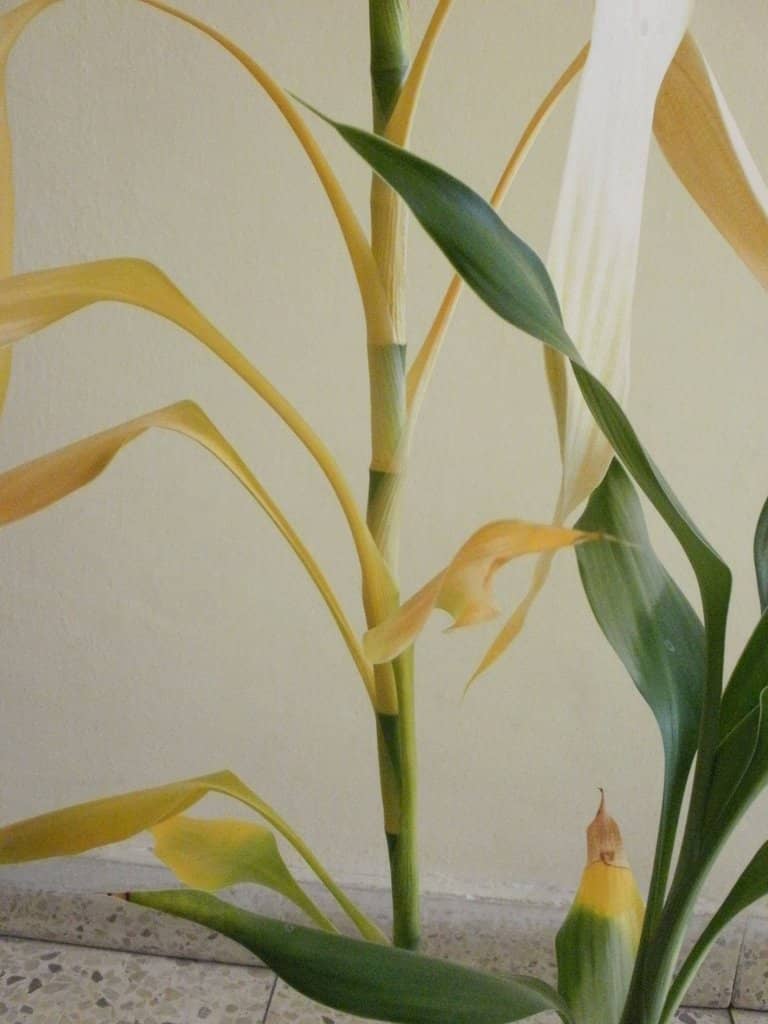
Related Questions on Bamboo In Aquarium
Can I use bamboo wood in an aquarium?
Yes. You can, but it depends on the bamboo species you use. If you are using lucky bamboo there is no problem. But if you want to use real bamboo you need to treat it with resin so it will not rot in water. As a material, bamboo timber is safe for an aquarium.
Just make sure there are no toxic chemical treatments on it, or sharp edges to catch on! It would be best if you also remembered that in certain cases, the wood would swell and potentially rot, so keep a close eye.
How long can a lucky bamboo survive?
The general lifetime for lucky bamboo is quoted as ten years. Because of the debate surrounding how to cultivate it properly, however, this is somewhat disputed. Some aquarists say that for a short number of years, it only really thrives like two years, while others have claimed that they have been keeping their bamboo for much longer than just a decade. Lucky bamboo can be planted anywhere in the aquarium due to its height range and flexibility.
How fast does my lucky bamboo grow?
When lucky bamboo has developed its roots, it will start a fast growth phase which can grow 19 inches within 5 to 6 months. There could be about ten to twelve growth phases, each taking about 2 weeks time period.
Will my Lucky Bamboo produce oxygen?
In the daytime, they can release oxygen. But at night time they consume oxygen to procure energy.
Can I plant Lucky Bamboo with my Betta?
You it’s safe. Your betta will sometimes love laying on bamboo leaves.
Does it need Fertilization?
The bamboo does not need to be fertilized as it already receives the nutrients from the fish waste. But it depends on the biological load of your fish tank. If the biological output is low, you might need to use fertilizer.
Leaves above or below the water?
It varies on how you want that to look, but there’s nothing wrong with both ways of holding it. But since the plant can thrive out of the water with its leaves. It is best to hold the leaves out.
Will it transfer toxic stuff into the water?
There are many other kinds of bamboos that are not good for fish tanks. So make sure you just buy lucky bamboo Dracaena Sanderiana .
Can I put my money plant in a fish tank?
Yeah, sure, you can put a money plant in an aquarium. It will absorb water nitrites to be used in its development. It is better to keep leaves out of the water while roots are in the water.
Read Nore : Spider Plant In Aquarium/Fish Tank | 15 Things To Know
How soon will bamboos rot in the water?
It differs on the type of bamboo used in the aquarium. Generally, they can live for 2 years. But in a fresh climate above the soil with direct sunlight, it can last for10 years or more.
Myths to Avoid
It can be a simple process growing lucky bamboo in your aquarium, although it is better to clear your head with many of the myths surrounding its growth.
Lucky Bamboo secretes toxins into an aquarium:
Lucky bamboo belongs to the family Dracaena, so it’s not going to rot in water. You could read that some people use bamboo sticks in their tanks. They sometimes fail to note that, to keep them from rotting, they are covered in a transparent resin and are thus not a living plants.
You can’t Fertilize Lucky Bamboo
We saw above that you can use fertilizer, but this is not a must. For safe, lucky bamboo growth, the water in your aquarium is enough. The beneficial bacteria can transform ammonia into nitrites when you have a well-cycled aquarium. Moreover, as we saw earlier, this is one thing; Lucky Bamboo loves to feed on it. But keep an eye of your tank’s biological output.
Leaves need to be above the water when Bamboo is In Aquarium
To thrive bamboo in an aquarium is not a necessity. grow Lucky Bamboo may submerged or partially submerged. If leaves are above water, they can keep a better oxygen exchange.
Can I grow lucky bamboo in my filter?
Yes, you can, but it is not necessary to do it. One problem you can face from this is it can clog up your fitter due to roots.
Conclusion
At last, I can say that lucky bamboo doesn’t hurt your fish. When buying bamboo, always confirm that you are buying the correct type of bamboo that is not toxic to your pet fish.
Bamboo aquarium décor ideas
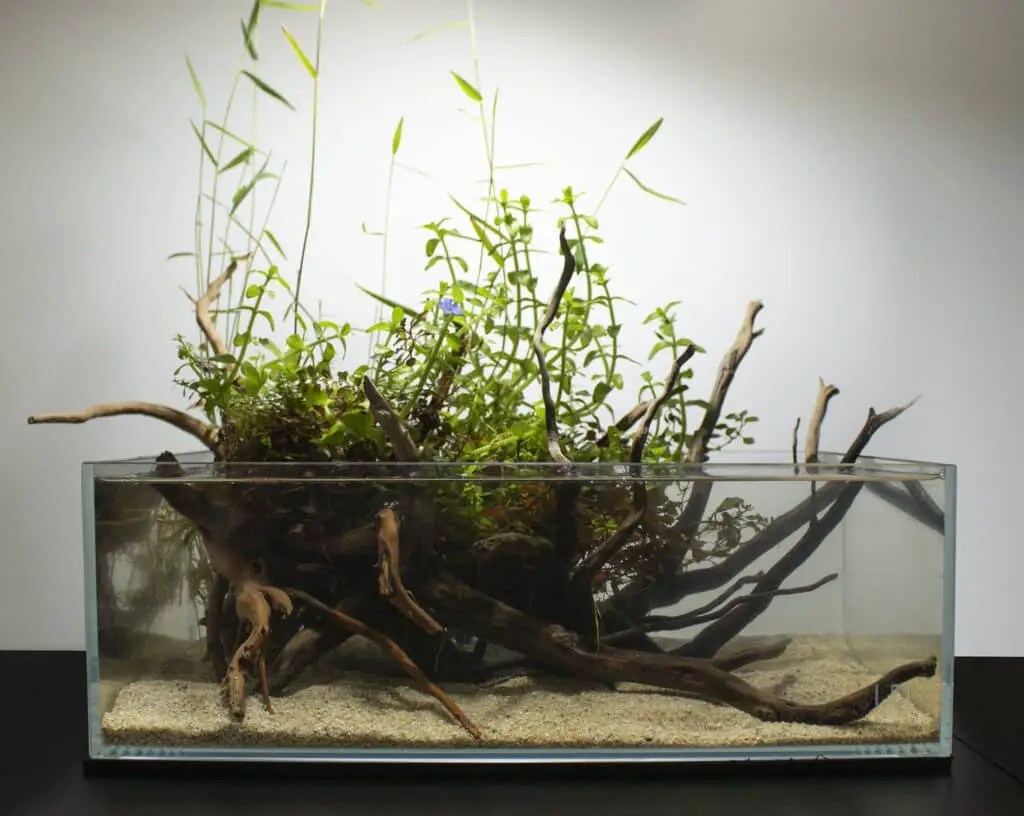


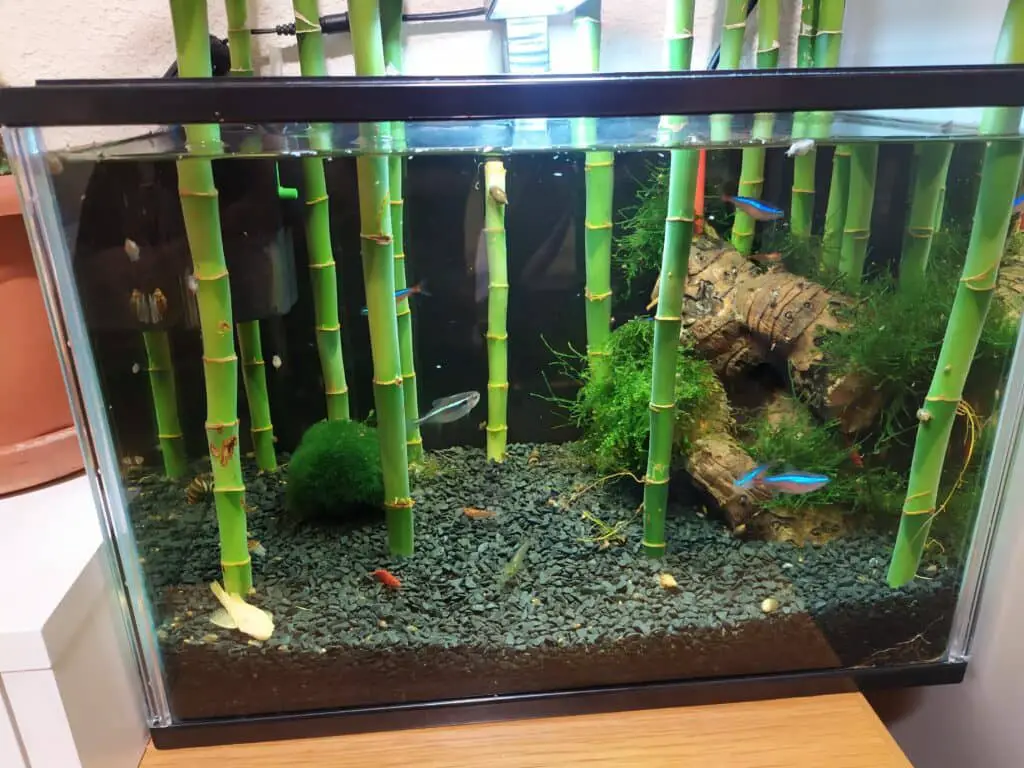
Read More Is It Safe To Put Dried Bamboo In An Aquarium?
Read More How To Get Driftwood To Sink? [SOLVED] Easy Way
